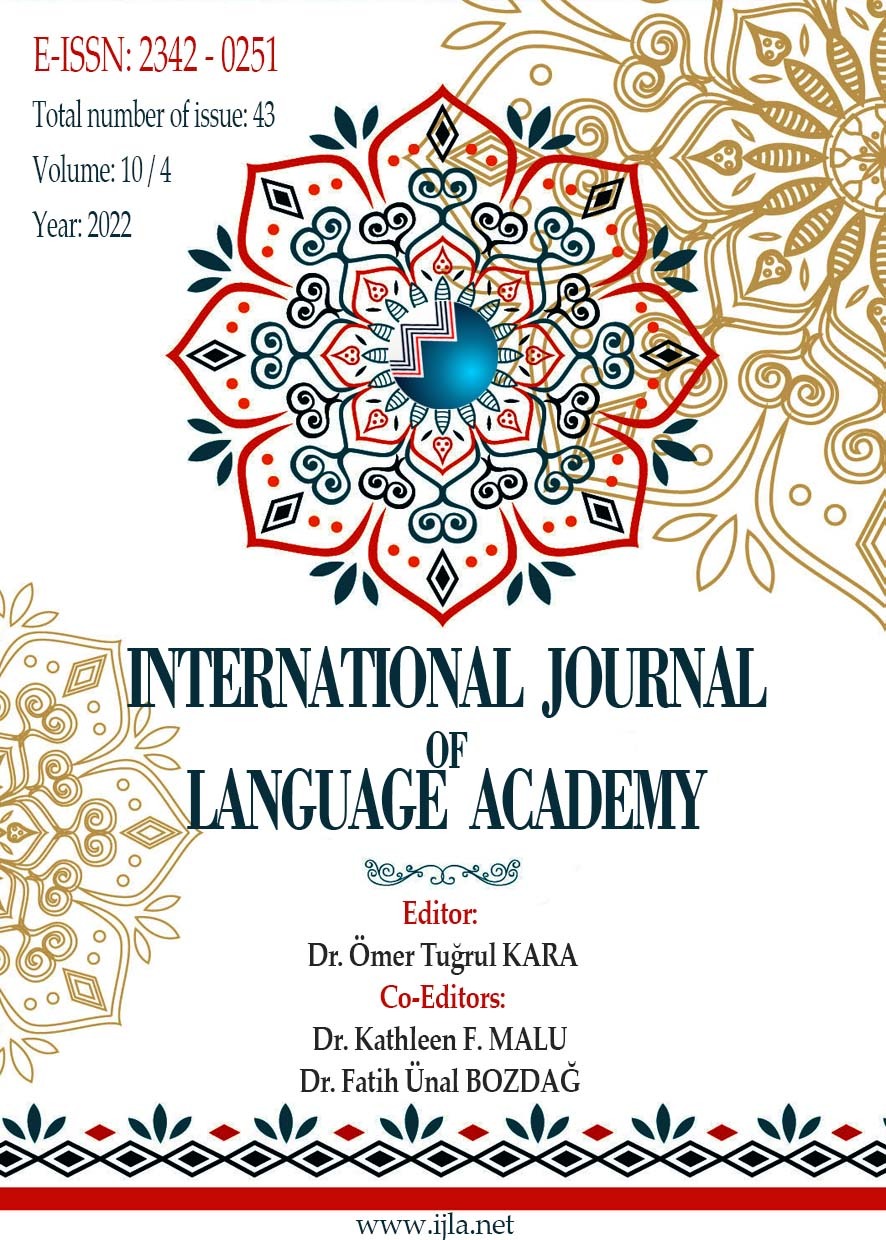Author :
Abstract
Edebiyat dairesi içinde bulunan çocuk edebiyatı taşıması gereken özellikler çerçevesinde kendine ait estetiği olan bir alandır. Sanat eseri öznel değerler üzerine inşa edilse de bazı nesnel değerleri de taşıması gereklidir. Burada kast edilen bir sanat eserini belli bir kalıba sokmak değildir. Özellikle son dönemde çocuk edebiyatına olan ilgi artarken bu alanda yeterli ve yetersiz pek çok kişinin kitap yazdığı görülmektedir. Çocuk kitaplarını çocuk okura sunan kişilerin de bir çocuk kitabında neler olması ve neler olmaması gerektiği ile ilgili bilgili olması önemlidir. Bu durumda bir çocuk edebiyatı eserinin estetik bir değer taşıyarak biçim ve içerik açısından belli kriterleri taşıyor olması gerekir. Çocuk okuru estetik açıdan doğru bir çocuk kitabı ile buluşturmak onda bir beğeni yargısı geliştirmesine yardımcı olacaktır. Bu beğeni yargısını geliştirmek ve olgunlaştırmak çocuktaki estetik farkındalığın meydana gelmesini sağlayacak estetik değer taşıyan eserler aracılığı ile tezahür etmektedir. Çalışmada belirlenen estetik ölçütler çocuk kitabı ile çocuk okur arasında köprü vazifesi gören kişiler için önemli bir yer tutar. Bu çalışma nitel araştırma deseninde doküman analizi yöntemi kullanılarak yapılmıştır. Araştırmanın amacı, çocuk edebiyatında estetik ölçütlerin belirlenmesi ve kurgu etrafında yazılan çocuk kitaplarını incelemeye yönelik analitik dereceli puanlama anahtarı hazırlanmasıdır. Araştırmanın sonucunda çocuk edebiyatı eserlerini incelemeye yönelik biçim ve içerik olarak 34 maddeden oluşan her maddenin 1-4 arasında puanlandırılabileceği analitik dereceli puanlama anahtarı geliştirilmiştir.
Keywords
Abstract
Children's literature in the literature circle is a field with aesthetics regarding the framework of the features. Although literacy art is built on subjective values, it must also carry some objective values. However, the aim is to expand the work beyond a specific mould. Especially recently, due to growing interest in children's literature, many experienced or unskilled authors have extensively published various works. People who present children's books to children must know what should and should not be in a children's book. In this case, a work of children's literature should have an aesthetic value and meet specific criteria in terms of form and content. Bringing the child reader together with an aesthetically correct work of art will help them develop a judgment of taste. Developing and maturing this taste is manifested through works of aesthetic value that will enable the aesthetic awareness of the child to flourish. The aesthetic criteria determined in the study have an important place for people who act as a bridge between the children's book and the child reader. Therefore, this study utilized document analysis with the aim of determining aesthetic criteria in children's literature and preparing an analytical rubric for examining fictional children's books. As a result of the research, an analytical rubric was developed, consisting of 34 items in terms of form and content to be scored between 1 and 4 for examining children's literature.
Keywords
- Akbayır, S. (2010). Çocuğum neyi okumalı: 9 ay- 14 yaş (2. bs.). Ankara: Pegem Akademi.
- Aktaş, C. M. (2019). Nitel veri toplama teknikleri. H. Özmen, & O. Karamustafaoğlu (Ed.), Eğitimde araştırma yöntemleri içinde (s.114-136). Ankara: Pegem Akademi.
- Alpay, M., & Anhegger, R. (1975). Çocuk edebiyatı ve çocuk kitapları. İstanbul: Cem Yayınevi.
- Ayre, C., & Scally, A. J. (2014). Critical values for Lawshe’s content validity ratio: Revisiting the original methods of calculation. Measurement and evaluation in counseling and development, 47(1), 79-86.
- Barett, T. (2015). Neden bu sanat, çağdaş sanatta estetik ve eleştiri. İstanbul: Hayalperest yayınevi.
- Bowen, G. A. (2009). Document analysis as a qualitative research method. Qualitive research journal, 9(2), 27-40.
- Demirel, Ş., & Deniz, H. (2021). 5. Sınıf Türkçe ders kitabındaki şiirlerin çocuğa görelik ölçütlerine göre incelenmesi. Uluslararası Türkçe Edebiyat Kültür Eğitim (Teke) Dergisi, 10(2), 720- 740.
- Dilidüzgün, S.(2000). Çocuk kitaplarında yazınsal nitelik. S. Sever (Ed.), I. Ulusal Çocuk Kitapları Sempozyumu içinde (s. 253-267). Ankara: Ankara Üniversitesi.
- Dilidüzgün, S. (2018). Çağdaş çocuk yazını: Yazın eğitimine atılan ilk adım (3. bs.). İzmir: Tudem.
- Erdoğan, F. (2019). İlk hevesten imza gününe... Çocuklar için yazmak. İstanbul: Binbirkitap.
- Erzen, J. N. (2011). Çoğul estetik. İstanbul: Metis yayınları.
- Forster, E. M. (2019). Roman sanatı. (U. Aytur, Çev.). İstanbul: Milenyum Yayınları.
- Gamble, N., & Yates, S. (2002). Exploring children’s literature. London: Sage.
- Gültekin, A. ( 2011). Çocuk ve gençlik edebiyatı yazıları. İstanbul: Erdem Yayınları.
- Güneş, F. (2000). Çocuk kitaplarının okunabilirlik ölçütleri açısından incelenmesi. S. Sever (Ed.), I. Ulusal Çocuk Kitapları Sempozyumu içinde (s. 334-349). Ankara: Ankara Üniversitesi.
- Günyüz, M. (2022). Çocuk edebiyatı okumaları: Kök metinler, metinlerarası ilişkiler, karşılaştırmalı okumalar. İstanbul: Erdem Yayınları.
- Kula, B. O. (2012). Kant, Schiller, Heidegger estetik ve edebiyat. İstanbul: Türkiye İş Bankası Yayınları.
- Kutlu, M. (2020). Vatan yahut internet. İstanbul: Dergâh Yayınları.
- Kılıç, S. (2015). Kappa test. Psychiatry and Behavioral Sciences, 5(3), 142-144.
- Lawshe, C. H. (1975). A quantitative approach to content validity. Personnel psychology, 28(4), 563-575.
- Lukens, R. J., Smith, J. J., & Coffel, M. C. (2021). Çocuk edebiyatına eleştirel bir bakış (2. bs.). (C. Pamay, Çev.). İstanbul: Erdem Yayınları.
- Nikolajeva, M. (20015). Aesthetic approaches to children's literature: An introduction. Scarecrow Press: United States of America.
- O’Leary, Z. (2014). The essential guide to doing your research project (2nd ed.). Thousand Oaks, CA: SAGE Publications, Inc.
- Rundell, K. (2019). Neden çocuk kitapları okumalıyız (2. bs.). ( Ş. Taş, Çev.). İstanbul: Domingo.
- Short, K. G., Lynch-Brown, C., & Tomlinson, C. M. (2014). Essentials of Children’s Literature. (7. bs.). United State of America: Pearson.
- Şirin, M. R. (1998). 99 soruda çocuk edebiyatı. İstanbul: Çocuk Vakfı Yayınları.
- Şirin, M. R. (2019). Çocuk edebiyatına eleştirel bir bakış. İstanbul: Uçan At Yayınları.
- Timuçin, A.(2019). Edebiyat estetiği konusunda kendimle konuşmalar. İstanbul: Bulut Yayınları.
- Tas ̧delen, V. (2005b). Çocuk edebiyatında yalınlık İlkesi. Hece. 104-105, 352-361.
- Tunalı, İ. (1998). Estetik. (5. bs.). İstanbul: Remzi Kitabevi.
- Yavuzer, H. (2006). Çocuk psikolojisi (29. bs.). İstanbul: Remzi Kitabevi.
- Yeşilyurt, S., & Çapraz, C. (2018). Ölçek geliştirme çalışmalarında kullanılan kapsam geçerliği için bir yol haritası. Erzincan Üniversitesi Eğitim Fakültesi Dergisi, 20(1),





